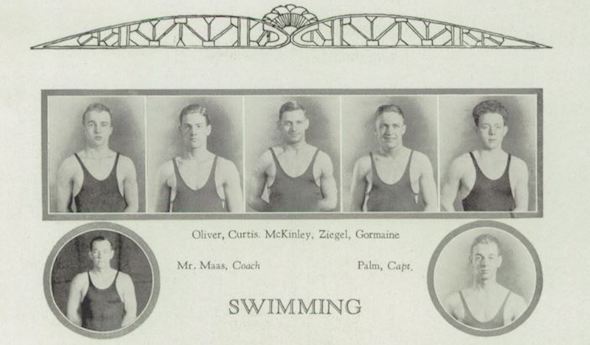
Michigan Boys Take the Swimming Plunge
November 30, 2018
By Ron Pesch
Special for Second Half
It was late March. Dressed in his black silk swimsuit adorned with an orange letter “J,” James Dingman stood 18 inches above the waterline, perched on a spring-less board. In 60 seconds it would be over.
With his arms outstretched into an inverted “V,” he dove face first into the 90-foot swimming pool. The tank, 30 feet wide, and located on the campus of Michigan Agricultural College (now Michigan State University), was the largest of its kind in the Midwest and measured 15 feet longer than a standard competitive pool.
“The aim of all plungers should be to leap as high into the air as possible and as far out as an open jack-knife will carry,” wrote Tom J. Clemens in the 1919-20 edition of the Wilson Athletic Library Official Swimming Guide, the bible of instruction and rules for swimming, diving, water games and lifesaving. “Nearly all plungers dive too flatly,” added the coach of the Detroit Y.M.C.A. swimming team. “A plunge is only as good as the dive.”
How long Dingman remained under water or at what distance he surfaced is not recorded. According to Clemens, a dive might bring the body to within six inches of the bottom of the pool. The best plungers remain under water as long as possible, angling upward at 40 degrees just as the force of the dive is spent. Record holders would surface 40 to 50 feet out into the water.
Upon surfacing, as per the rules of the event, Dingman glided along the surface, without the aid of propulsion from his arms or legs, for a measured distance of 63 feet. The mark fell two feet short of his performance in the prelims. Still, it was the best of the day and earned him a first place finish at the 1925 team state swimming championships.
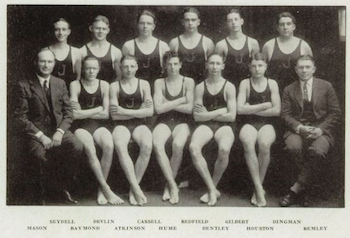 While its origins are unclear, the plunge for distance dates back to at least 1865. In 1904, it appeared as an Olympic diving event, and then disappeared from the games. By the 1920s, it was rapidly losing popularity. The plunge appeared only twice in the Michigan high school state title meets. The first time was in 1924 in what was Michigan’s first swimming and diving championships. Sanctioned by the Michigan Interscholastic Athletic Association (MIAA), the immediate predecessor to the modern-day Michigan High School Athletic Association (MHSAA), a total of nine teams – Northern, Northwestern and Southeastern, all of Detroit; Highland Park, Ann Arbor, Jackson, Lansing, Battle Creek Lakeview and Flint Central – took part in the event.
While its origins are unclear, the plunge for distance dates back to at least 1865. In 1904, it appeared as an Olympic diving event, and then disappeared from the games. By the 1920s, it was rapidly losing popularity. The plunge appeared only twice in the Michigan high school state title meets. The first time was in 1924 in what was Michigan’s first swimming and diving championships. Sanctioned by the Michigan Interscholastic Athletic Association (MIAA), the immediate predecessor to the modern-day Michigan High School Athletic Association (MHSAA), a total of nine teams – Northern, Northwestern and Southeastern, all of Detroit; Highland Park, Ann Arbor, Jackson, Lansing, Battle Creek Lakeview and Flint Central – took part in the event.
The 1925 championships was the first run by the MHSAA. Also staged at the M.A.C. pool, it featured a 10th team – Detroit Cass Tech. Dingman’s performance, combined with teammate Dick Seydell’s surprising first-place finish in the fancy diving competition and Jack Redfield’s second in the 100-yard freestyle, helped Jackson High School earn an unexpected runner-up finish in only its second year of competition.
Following the actions of the NCAA, the state association removed the plunge from the schedule of competition prior the 1926 championship meet.
Fancy diving and my plunge into uncharted waters
My ‘job” as MHSAA historian, (which is really just a fascination with prep sports history) has always been to fill in holes that surface when I, the various members of the MHSAA staff or the state’s television, radio or newspaper media, seek answers to a question. I’m a detail guy, who earned my living as a business analyst compiling, normalizing and studying data. I love diving deeper into information, completing lists and unearthing stories to tell.
From the first trophy awarded by the MHSAA in 1925, and then for the next 20 years, the state’s 35 team swimming championships never strayed beyond the borders of four Michigan counties: Wayne, Washtenaw, Calhoun and Jackson. Two of those counties, Washtenaw and Calhoun, accounted for 24 of those 35 titles.
Within those borders, only eight schools claimed titles during those two decades, with two schools combining for 18 of those awarded championships.
Detroit dominates
The Detroit area dominated statewide competition in the earliest days. The metro area boasted many of the state’s finest high schools, offering students, male and female, a wide array of athletic facilities and opportunities. During the 1920s, the schools dominated across a variety of sports, including swimming where Detroit Northwestern, Detroit Northern and Highland Park battled for annual city, state and, often, mid-west supremacy.
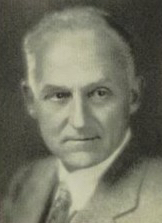 From 1925-1927, Detroit Northwestern, coached by Bert Maris, won the MHSAA’s Open Class swimming competitions, featuring all schools regardless of enrollment. A former coach at University of Michigan and Notre Dame, Maris accepted the position of athletic director at the newly-opened Northwestern High School in 1914, and stayed for 28 seasons before retiring in 1942. Like many mentors from the era, he coached multiple sports, winning state titles in basketball, track, and swimming. Over the years he worked with an amazing number of athletes, including football legend Knute Rockne and track stars Eddie Tolan and Willis Ward. Maris’ teams actually won four swimming titles in a row, as Northwestern topped Jackson in that 1924 MIAA prep championship. That meet featured eight events. Besides the plunge, and fancy diving, it included the 50, 100 and 220-yard freestyles, the 50-yard breaststroke, the 50-yard backstroke, and the 120-yard relay.
From 1925-1927, Detroit Northwestern, coached by Bert Maris, won the MHSAA’s Open Class swimming competitions, featuring all schools regardless of enrollment. A former coach at University of Michigan and Notre Dame, Maris accepted the position of athletic director at the newly-opened Northwestern High School in 1914, and stayed for 28 seasons before retiring in 1942. Like many mentors from the era, he coached multiple sports, winning state titles in basketball, track, and swimming. Over the years he worked with an amazing number of athletes, including football legend Knute Rockne and track stars Eddie Tolan and Willis Ward. Maris’ teams actually won four swimming titles in a row, as Northwestern topped Jackson in that 1924 MIAA prep championship. That meet featured eight events. Besides the plunge, and fancy diving, it included the 50, 100 and 220-yard freestyles, the 50-yard breaststroke, the 50-yard backstroke, and the 120-yard relay.
The 1925 meet, in which Dingman competed, included the same events and added the 300-yard medley relay, comprised of the 60-yard backstroke, 60-yard freestyle, 60-yard breaststroke and 120-yard free. While Northwestern repeated as team champion, Gurdon Guile of Flint Central “was the star of the meet, with a first in the 100-yard freestyle and a second in the 50-yard freestyle.”
OPEN CLASS
|
Year |
Champion (Coach) |
Runner-Up |
|
1925 |
Detroit Northwestern (Bert Maris) |
Jackson |
|
1926 |
Detroit Northwestern (Bert Maris) |
Highland Park |
|
1927 |
Detroit Northwestern (Bert Maris) |
Highland Park |
|
1928 |
Highland Park (Grant Withey) |
Detroit Northern |
The 1926 championships featured 10 Michigan high schools, including Belding, a newcomer to state swimming circles. Horace Craig, later a star swimmer at Michigan State, trimmed eight seconds from the 220 freestyle record in leading Northwestern to its third straight title in 1926. He again topped the mark in the preliminaries in 1927 as Northwestern posted 57 points, outdistancing runner-up Highland Park by 34.
In 1928, Highland Park jumped to the forefront, qualifying 10 of 26 swimmers in preliminary competition – more than twice the number of any other school – then unseated the four-time champions in the finals to win the competition. The Polar Bears topped six state meet records (including Craig’s 220 freestyle mark) along the way. Then, led by Louis Lemak and Bob Klintworth, future swimmers at the University of Michigan, Highland Park repeated as champion in 1929 when MHSAA competition was split into Class A for the state’s largest schools based on enrollment and Class B-C-D to handle all other schools with swim programs in the state. Roosevelt High, one of two high schools in Ypsilanti, grabbed the Class B-C-D crown, with East Grand Rapids finishing second.
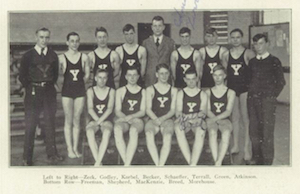 In the spring of 1930, Central High School in Ypsilanti eked past East Grand Rapids by a single point to top a field of seven schools competing for Class B-C-D honors. It was the first of four straight titles for Ypsilanti Central and their coach, James Schaffer, over a five-year span. (In 1932, the Indians finished runners-up to River Rouge. Rouge, in turn, finished second to Ypsilanti in 1931, 1933 and 1934).
In the spring of 1930, Central High School in Ypsilanti eked past East Grand Rapids by a single point to top a field of seven schools competing for Class B-C-D honors. It was the first of four straight titles for Ypsilanti Central and their coach, James Schaffer, over a five-year span. (In 1932, the Indians finished runners-up to River Rouge. Rouge, in turn, finished second to Ypsilanti in 1931, 1933 and 1934).
Detroit Northwestern returned to the pedestal in 1930, earning another title against a field of 14, this time with Leo S. Maas as coach. It would be the last swimming title awarded to a Detroit Public League school.
With the arrival of the 1930-31 school year, Detroit public schools withdrew from state interscholastic competition, to focus only on intramural contests between other Detroit city schools. Vaughn S. Blanchard, who took charge as Director of Health and Physical Education for the Detroit Public Schools in 1929, cited in the decision his belief that there was an unhealthy overemphasis on competitive athletics. The voluntary exile would last for the next 30 years and recast competition within Michigan prep athletics.
Maas’ teams would continue to dominate Detroit swimming, winning 7 of 9 City League championships. In September of 1938, he joined the staff of Wayne University as swimming coach, leading the Tartars to national prominence in the 1940s. He spent 20 years at the school, renamed Wayne State University in 1956.
Battle Creek Takes Charge
Charles McCaffree, Jr. was born in South Dakota and learned to love swimming at the YMCA pool in Sioux City. He followed his brother to the University of Michigan, earning three varsity letters under internationally-known swimming coach Matt Mann. Following college graduation in 1930, McCaffree was hired at Battle Creek Central as swimming coach in 1931. For the next six years, 1931-1936, his Bearcats teams won Michigan swimming titles. All were in Class A, with the exception of the 1935 tournament, when, because of the Great Depression, only a single title was awarded. A total of 139 swimmers from 14 teams competed in the state’s 12th annual meet, held at the intramural pool at the University of Michigan.
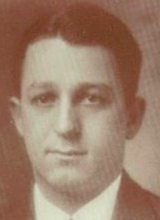 The MHSAA returned to two class championships in the spring of 1936. Ypsilanti Roosevelt returned to the winners’ circle, besting Ypsilanti Central by two points, 38 to 36, while winning four first places in the eight-event meet.
The MHSAA returned to two class championships in the spring of 1936. Ypsilanti Roosevelt returned to the winners’ circle, besting Ypsilanti Central by two points, 38 to 36, while winning four first places in the eight-event meet.
In September 1936, McCaffree returned to U-M to take over the Wolverines program while Coach Mann attended to his seriously ill father in Leeds, England. McCaffree’s teams at Battle Creek had won 53 dual meets and lost only three. He helped build the district’s junior high swim program and turned out 14 prep All-Americans, (including Dobson “Dobbie” Burton, captain of Michigan’s 1941 NCAA championship swim team and later, a very successful swim coach at Evanston Township High School in Illinois). With Mann’s return to the helm at Michigan in February 1937, McCaffree accepted the head swimming coaching position at Iowa State, where his teams won four Big Eight Conference Championships.
In 1942, “Coach Mac” was hired by Michigan State athletic director Ralph Young to head the Spartans swim team. For the next 28 years, he guided the team as head coach, winning eight straight Central Collegiate Conference championships prior to State’s entry into the Big Ten. In 1957, he led MSU to its first Big Ten swimming title. Before retiring as coach in 1969, “his student-athletes earned All-American honors 322 times, won 34 Big Ten titles, and claimed 22 NCAA titles. Six individuals qualified for the Olympics.” In 1979, the university named the pools within the Intramural-West Building in his honor.
CLASS A
|
Year |
Champion (Coach) |
Runner-Up |
|
1929 |
Highland Park (Grant Withey) |
Detroit Northern |
|
1930 |
Detroit Northwestern (Leo. S. Maas) |
Detroit Northern |
|
1931 |
Battle Creek Central (Charles McCaffree) |
Lansing Central |
|
1932 |
Battle Creek Central (Charles McCaffree) |
Kalamazoo Central |
|
1933 |
Battle Creek Central (Charles McCaffree) |
Lansing Central |
|
1934 |
Battle Creek Central (Charles McCaffree) |
Lansing Central |
OPEN CLASS
|
Year |
Champion (Coach) |
Runner-Up |
|
1935 |
Battle Creek Central (Charles McCaffree) |
Dearborn Fordson |
CLASS B-C-D
|
Year |
Champion (Coach) |
Runner-Up |
|
1929 |
Ypsilanti Roosevelt (Howard Farnslow) |
East Grand Rapids |
|
1930 |
Ypsilanti (James Schaffer) |
East Grand Rapids |
|
1931 |
Ypsilanti (James Schaffer) |
River Rouge |
|
1932 |
River Rouge (Benny Goodell) |
Ypsilanti |
|
1933 |
Ypsilanti (James Schaffer) |
River Rouge |
|
1934 |
Ypsilanti (James Schaffer) |
River Rouge |
Ypsilanti, Jackson emerge
McCaffree’s replacement at Battle Creek, John Vydareny, led the Bearcats to a seventh consecutive title in 1937. The city of Ypsilanti retained control of the Class-B-C-D title, as Ypsilanti Central dethroned Roosevelt High 71-54. It was the first of three consecutive by Central High and coach James Schaffer.
“More than 200 high school swimming stars churned the Michigan State college pool today as they warmed up for trials in the 15th annual Michigan High School Athletic association championship swim,” noted The Associated Press in 1938 pre-event coverage.
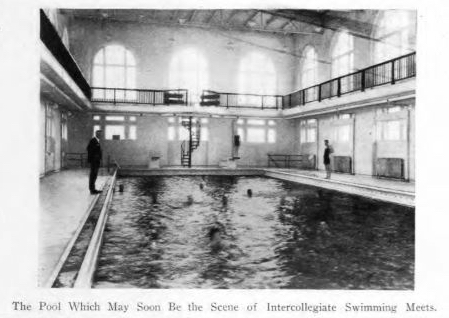 A broadcast, featuring a running account of the meet, was recorded in East Lansing that Saturday and brought to Battle Creek for an 11:00 p.m. broadcast on radio station WELL-AM. Designed to give listeners “the pool’s edge atmosphere of the meet,” the program was replayed on Sunday evening “to give those who did not attend, and those who retired too early to hear the Saturday night program.”
A broadcast, featuring a running account of the meet, was recorded in East Lansing that Saturday and brought to Battle Creek for an 11:00 p.m. broadcast on radio station WELL-AM. Designed to give listeners “the pool’s edge atmosphere of the meet,” the program was replayed on Sunday evening “to give those who did not attend, and those who retired too early to hear the Saturday night program.”
Jackson, which lost the Five-A league title to Battle Creek, emerged as the Class A winner. Both schools brought 22 to the event.
“Jackson dethroned the Bearcats…in the Michigan State college natatorium and the difference between an eighth successive crown and runner-up position … was disqualification of the Battle Creek Medley relay team in the preliminaries. The Bearcat medley trio finished a full half lap in front of the field … in record time … but it was ruled out …”
Jackson finished with 39 points, followed by Battle Creek with 32. The Vikings would repeat as Class A champions in both 1939 and 1940. Coach Elwood Watson’s swimmers would pick up a fourth title in 1942. Battle Creek Central added three additional titles to their total with wins in 1941, 1943 and 1944. Because of World War II restrictions, only 13 schools entered the Class A meet and five competed in Class B-C-D in 1943, while 14 schools participated in the Class A meet in 1944 at Michigan State, and six schools chased honors in the Class B-C-D competition at the University of Michigan.
With the absence of Detroit schools during the 14-year span, 1931 through 1944, a member of the 5-A League – comprised of Battle Creek, Jackson, Ann Arbor, Lansing Eastern and Lansing Central – controlled Michigan’s Class A swim title during that time. On nine occasions during that period, the 5-A also placed the state runner-up.
I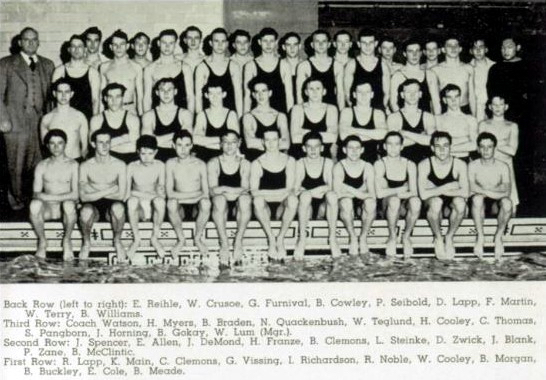 n Class B-C-D, Ann Arbor University High emerged as a swimming power, finishing as runner-up to Ypsilanti Central in both 1938 and 1939. Guided by University of Michigan assistant swimming coach Harvey Muller, the Cubs ended the city of Ypsilanti’s grip on the smaller school title in 1940.
n Class B-C-D, Ann Arbor University High emerged as a swimming power, finishing as runner-up to Ypsilanti Central in both 1938 and 1939. Guided by University of Michigan assistant swimming coach Harvey Muller, the Cubs ended the city of Ypsilanti’s grip on the smaller school title in 1940.
“University High’s crack free-style quartet of Bill Koch, Earl Bryant, Jim Gordy and Max Tobias nosed out Central in the final relay to overcome a 43-42 lead which Ypsilanti held prior to the event.”
With the win, “the Ann Arbor tankers scored 52 points, one more than Central … It was Central’s first defeat in the state meet in the last four years.”
Ypsilanti Central topped Roosevelt in the 1941 state meet, this time under the guidance of coach Christy Wilson. University High won the first of five straight titles, with Muller as coach in 1942 and the legendary Matt Mann guiding the team from 1943 to 1946. Among the winners in 1943 was Matt Mann, Jr., who clipped five seconds off the meet’s 200-yard freestyle record. He would later be named a four-time All-American at Michigan and compete on the university’s 1948 national championship swim team. Following graduation, Mann, Jr. coached swimming and diving at Lansing Sexton High School.
Times Change
Post World War II saw many changes to society, cities, and, within competitive swimming, new record setters and coaching legends emerged. In 1980, a separate boys tournament was added to the MHSAA menu for Michigan’s Upper Peninsula. The grouping of schools moved from classes to divisions in 2003, and in 2008, a third division was added.
Today, ownership of MHSAA boys swimming & diving titles has geographically traveled a bit farther, but still to only 12 of Michigan’s 68 Lower Peninsula counties.
 Ron Pesch has taken an active role in researching the history of MHSAA events since 1985 and began writing for MHSAA Finals programs in 1986, adding additional features and "flashbacks" in 1992. He inherited the title of MHSAA historian from the late Dick Kishpaugh following the 1993-94 school year, and resides in Muskegon. Contact him at [email protected] with ideas for historical articles.
Ron Pesch has taken an active role in researching the history of MHSAA events since 1985 and began writing for MHSAA Finals programs in 1986, adding additional features and "flashbacks" in 1992. He inherited the title of MHSAA historian from the late Dick Kishpaugh following the 1993-94 school year, and resides in Muskegon. Contact him at [email protected] with ideas for historical articles.
PHOTOS: (Top) The 1930 Detroit Northwestern team was among early state swimming powers. (2) Jackson's 1925 team also was an early force in the sport. (3) Bert Maris. (4) The 1930 Ypsilanti team. (5) Charles McCaffree, Jr. (6) The Michigan Agricultural College pool, in 1921. (7) The 1940 Jackson team. (Photos collected by Ron Pesch.)
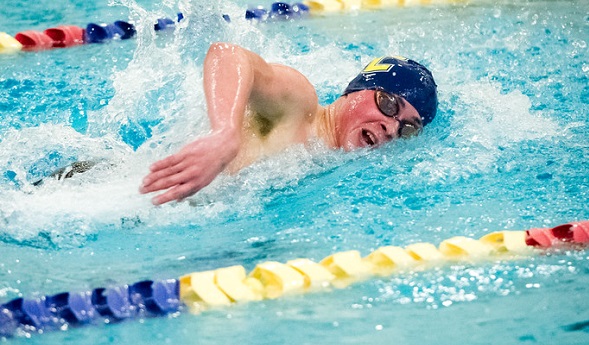
Central Awaits Fast Finishes, New Home
By
Pam Shebest
Special for MHSAA.com
February 20, 2018
PORTAGE — Thursday night was an emotional one for the Portage Central boys swimming & diving team, and not only because it was Senior Night.
 The Mustangs’ 114-69 win against St. Joseph was the last meet in the 44-year-old pool located at the middle school.
The Mustangs’ 114-69 win against St. Joseph was the last meet in the 44-year-old pool located at the middle school.
“They’re building a new pool at the high school,” Central coach Jim Schafer said. “It’s bittersweet after spending 33 years coaching in this pool; (there are) a lot of great memories.
“A lot of great student athletes have been part of the program. The old pools have served Portage very well, and I’m sure the new ones will serve just as well for the future of Portage Aquatics.”
The future is bright for the program – but so is the present.
The Mustangs are ranked No. 8 in the latest Lower Peninsula Division 2 state poll heading into the Southwest Michigan Athletic Conference meet Friday and Saturday at Battle Creek Lakeview.
The Mustangs have won 19 conference titles, including last year’s when they shared the crown with Kalamazoo Loy Norrix.
“There are a lot of good teams there,” Schafer said. “Mattawan gave us a really good meet last week. Norrix has a lot of good kids; so does St. Joe.
“Battle Creek Lakeview is always strong. It’s going to be a tight race between a lot of teams.”
The Mustangs, who take an 11-1 dual record into the meet, are no slouches in the pool.
After finishing eighth in LPD2 last year, they already have qualified four finalists from that team.
Oakland University will host this year’s championship meet March 9-10.
Star power
Owen Miller, the reigning LPD2 champ in the 200-yard freestyle, is just a junior and, while nostalgic for the pool where he set two varsity records, he is looking forward to the new one.
“I’m very excited for that,” he said. “We were shown the layout of the pool a while ago, but I forget what it looked like. I remember I liked it, but I’m not sure why.
 “It’s going to be a much larger pool. More locker rooms.”
“It’s going to be a much larger pool. More locker rooms.”
Miller also finished third in the 500 freestyle at the Finals last year and swam the first leg of the 400 freestyle relay with junior Sam Weber, senior Jacob Cole and Jack Rogers, who graduated last year. They placed eighth.
“Owen’s a quiet, hard-working guy,” said Schafer, who also teaches physical education, health and sports science at the high school. “As far as our team, he’s a great freestyler, but he can also swim other events as well.
“He’s one of our go-to guys that I can go to at any meet and say I need you to swim this. We’re fortunate enough that we have a handful of those kids. We have a pretty versatile lineup.”
Swimmers on the 10th-place 200 medley relay team were Rogers, who is now a freshman on the Wayne State University swim team, Weber, Cole and junior Jack Liu.
Cole also placed 11th in the 200 IM.
“Swimming is such a mental sport,” Cole said. “People don’t understand. Once you get up on the blocks, you don’t hear anything else. When he says ‘Take your mark,’ everyone has to be quiet in the building. There’s no noise.
“All that pressure that’s on you before you go in the race, it’s all gone for that moment before the buzzer’s released. It’s just like you and the water, and it feels like practice again.”
Cole’s brother Christopher also competed for the Mustangs.
“I’ve coached several brothers, which is kinda nice because you know the families,” Schafer said.
“Jacob brings good solid leadership. He works real hard and is a great all-around kid.”
With his brother holding team records in the 200 individual medley and 100 breaststroke, Jacob Cole has plenty of motivation.
“This year I’m trying to break his record in the 200 IM, so that’s my main goal,” he said. “I like to think I’m close. I’m at 1:58 and he’s at 1:55, so hopefully I can go 1:54 and beat it by a lot.
“I don’t really excel in any of the major strokes, but I’m generally pretty good at every stroke,” Cole added. “My favorite event is the 400 IM which isn’t offered in high school, so I go in the 200 IM.”
Miller holds the school record in the 500 free with a time of 4:33.22 and as part of the 400 free relay (1:26.44) with Cole, Weber and Rogers. Weber was ninth in the 500 free and 10th in the 100 backstroke at the MHSAA Finals last year.
Last year, Miller swam the first leg on the relay team, which was fine with him.
“I like it because I like to go out and try my best to get a lead, and then it takes some pressure off coming to the finish,” Miller said. “I like to cheer on my teammates as they come in.
“I enjoy them both (relays and individual competition). I think relays are more fun in that it’s the team and you’re working together, and it’s more of an accomplishment if you place high. Individuals, you have a little more self pride that you did this all yourself.”
Ready for Finals
Some teams do something special to bond during tournament time, but don’t count the Mustangs among them.
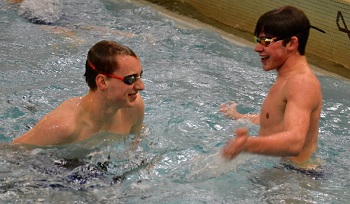 “We’re not shaving our head, that’s for sure,” Miller said, laughing. “We’re going to veto that one if the seniors bring it up.
“We’re not shaving our head, that’s for sure,” Miller said, laughing. “We’re going to veto that one if the seniors bring it up.
“They talked about bleaching our hair, but we kinda talked them down to frosted tips style, but we’ll see if we actually go through with it.”
Schafer said there is a reason for Portage Central’s success.
“We’ve got some pretty hard-working kids and there are two good age-group programs in the area, which help feed into our program,” he said.
“We’re fortunate enough to work with kids who already have a good swimming background when they come in.”
Cole gives credit to his coach.
“Schaf’s the best,” he said. “He’s an amazing coach. Whenever I come to the high school season, I’m always excited because the team camaraderie is really great. It’s just a fun time, and I think Schaf brings that out in everybody. One of the three goals is building relationships, and that’s one thing we say.
“It’s great if you’re winning, but at the end of the day were you a good sport while you were doing it? Did you make friends during the season? Was it fun? What’s the point of a sport if you’re not having fun while you’re doing it?”
Schafer has just three other seniors on the team: Caleb Calnin, Ferris Ghazal and Ethan Kloosterman.
Juniors are Harrison Fitts, Alex Galer, Christian Huitema, Josh Parsons, Veeresh Rajendran, Jace Rozankovich, Sheldon Shen and Nikhil Velagalety.
Sophomores are Jacob Crump, Connor Meyer, Logan Misejka, Saad Qureshi and Matt Walsh, and freshmen are Juan Barrera, Andrew Burhans, Ethan Earle-Glinsky, Isaac Hogue, Thenuka Jayatilaka, David Jin, Lucas Miller, Ben Miller, Emery Rahrig, Liam Roehr, Max Schramm, Frans Tanade and Jim Zesiger.
 Pam Shebest served as a sportswriter at the Kalamazoo Gazette from 1985-2009 after 11 years part-time with the Gazette while teaching French and English at White Pigeon High School. She can be reached at [email protected] with story ideas for Calhoun, Kalamazoo and Van Buren counties.
Pam Shebest served as a sportswriter at the Kalamazoo Gazette from 1985-2009 after 11 years part-time with the Gazette while teaching French and English at White Pigeon High School. She can be reached at [email protected] with story ideas for Calhoun, Kalamazoo and Van Buren counties.
PHOTOS: (Top) Portage Central’s Owen Miller is a reigning MHSAA Finals champion. (Middle) From top: Central coach Jim Schafer, Miller and Jacob Cole. (Below) Cole and Miller enjoy a lighter moment during a break. (Top photo by Mike Peterson, head shots by Pam Shebest and below photo by Colleen Ruggerio.)

